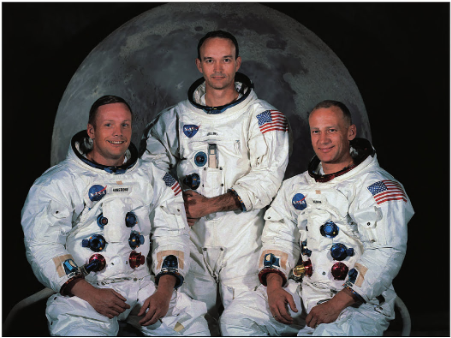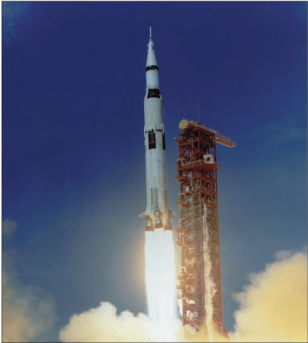At the height of the Cold War between the United States and the Soviet Union, another competition was born between the warring countries. The technological advances post-World War II allowed for both countries to begin experimenting with the possibility of launching into space, thus the race to become the first country in space was born. Today, the Cold War and Space Race is an equally frightening and exciting time in American history. Here, we’re looking at the events that led up to Buzz Aldrin and Neil Armstrong’s legendary first walk on Earth’s nearest celestial neighbor.
Soviet and American Rocket Development
At the end of World War II, the Soviet Union still occupied a small region of eastern Germany. Soviet leader Joseph Stalin sent the country’s best rocket engineers to the area to uncover what they could use to build advanced weapon systems. The hunt was led by Sergei Korolev, who became the chief rocket and spacecraft engineer of the USSR after the war. With the scraps recovered from eastern Germany, Korolev and his team began the initial stages of rocket construction.
Meanwhile, Robert H. Goddard, an American professor, was busy developing the technology for solid-propellant rockets, a rocket that is pushed by fuel. He also began working on liquid-propellant rockets in 1921, but his efforts were still being dismissed by the science community. Little did he know it at the time, but Goddard’s early work would become the framework for future launches. In 1945, the United States Army’s White Sands Proving Ground began constructing V2s, small rockets with photographic capability, and launching them into space. These rockets provided some of the first pictures from outer space.
The Cold War and Space Race Begins
When Americans developed the first atomic bomb, they had full control of the weapon’s technology. However, soon after the war, the Americans received word that the Soviets had detonated an atomic weapon of their own. For the first time, Americans realized they didn’t have complete reign over such a potentially devastating weapon. The possibility of attack by both sides led to tense political relations and loose threats from both sides. Both the American and Soviet public feared an atomic bombing any day.

With the development of atomic weapons on both sides, the Cold War in part evolved into a competition to see which country could develop the most advanced pieces of technology. By 1955, both countries had ballistic missiles that could reach space. In August of this year, Korolev got the Soviet Academy of Sciences to state its intent to beat the Americans into space. This declaration is considered the start of the Space Race.
Information surrounding the development of space rocket projects was considered top secret. On September 20, 1956, Americans used a research-only missile to launch Jupiter-C into space. The flight was brief, v and it served as merely a test, but Korolev heard of the Americans progress and opted to speed work on his end. In August and September of that year, Korolev successfully launched two R-7 rockets, which helped him fine-tune the technology that would be used to send Sputnik into space.
On October 4, 1957, the Soviets launched Sputnik 1 into orbit. At first, the crew was met with silence. When the satellite’s beeping came through, the Soviets rejoiced, knowing they were the first country to have a satellite make a full orbit around Earth. Four months later, America launched its first successful rocket. However, in response to the USSR’s victory, President Eisenhower asked that a program be created and dedicated to nonmilitary space exploration. As a result, in 1958, the National Aeronautics and Space Administration (NASA) was established.
In 1961, the USSR again shocked the world when it sent the first man into space. Yuri Gargarin completed one orbit around Earth in Vostok 1 before returning safely to the planet’s surface. Gargarin became a national hero after his 108 minutes in space. There was some debate about whether the flight counted as the first man in space, as the capsule was guided by engineers on the ground. Regardless of the technicalities, it was regarded globally as a monumental success.
Sights Are Set On the Moon
Before Gargarin made his orbit, President John F. Kennedy was not a full supporter of the American space program. After seeing what it would cost the government to put a man on the moon, Kennedy rejected it simply for the reason that it was too expensive. However, after the Soviets’ accomplishment, Kennedy was prompted to action. He made a daring statement, and promised to have an American on the Moon by the end of the 1960s. With this statement, the famous Apollo Program was born.

A year after the Soviets put a man in space, John Glenn became the first American to orbit Earth. NASA replicated this flight three more times, each time extending the orbit and testing the boundaries of their technology. Between 1965 and 1966, NASA launched the Gemini program, a series of manned space missions in which Americans accomplished the longest spaceflight, successfully docked two orbiting stations, and proved it was possible for an astronaut to work outside the spacecraft.
Tragedy struck the NASA Apollo program about a month before its scheduled launch for the Moon. During a grounded practice test, the Apollo 1 interior caught on fire while the crew was trapped inside. The entire crew perished. Apollo 4, 5, and 6 were all unmanned launches, wary to avoid such tragedies again. Apollo 7 and 8, manned Earth orbits, were both complete successes, and reaffirmed confidence in the Apollo technology. Apollo 10 delivered a Lunar Module to the Moon’s surface, and the stage was finally set.
The goal of Apollo 11 was to land three men in the Sea of Tranquility on the Moon. On July 16, 1969, the three men launched from Kennedy Space Center Launch Complex 39. In all, the trip to the Moon took three days. When they finally arrived, Neil Armstrong was the first to step foot on the lunar surface. Buzz Aldrin joined him 20 minutes later.
It’s estimated that about 723 million people watched the Moon landing live. Eight days after the astronauts took off, they safely splashed down in the Atlantic Ocean thus making America the victor in the race for the Moon. After this, competition between the two countries began to wane. The three Americans who manned Apollo 11 became international heroes. Their accomplishment marked the beginning of a new era of space science in countries around the world. They had proven the impossible, possible and made history.

